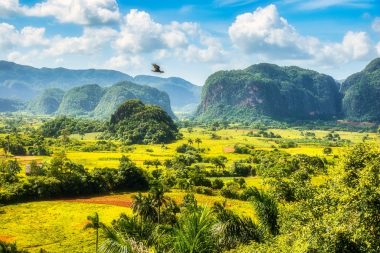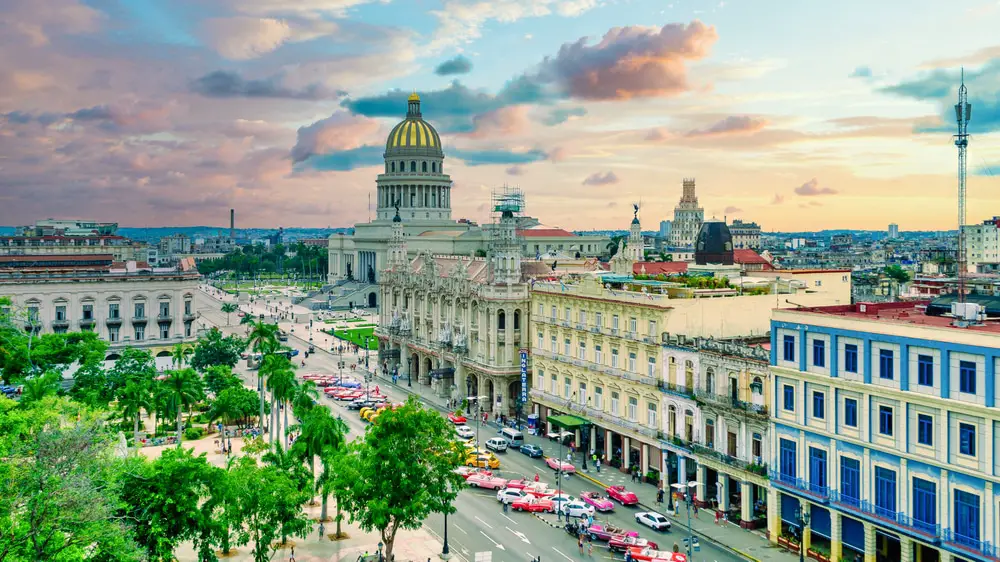The Caribbean is a place of longing for stress-ridden Europeans and offers the best conditions to unwind. White-powdered beaches, surrounded by the turquoise sea with its magical coral reefs, while the bright red sun sends out its cosy warmth in the blue fairytale sky – that’s what the Caribbean stands for. A fun-loving population with its diverse musical performances does the rest to get tourists in the holiday mood.
Culturally, Spain’s colonial buildings provide insights into a past that meant the development of power for the conquistadors and slavery for the locals. Cuba is the largest island in the Caribbean and a unique adventure, not least because of its special political position.
The most important information at a glance
Cuba stands out for its elongated shape, with the capital Havana in the west and Santiago de Cuba in the east marking the political centers. While the southern coast of Cuba is reached by the Caribbean Sea, on the northwest coast it is the Gulf of Mexico and on the rest of the north coast the Antilles that shape the current of the sea from the Atlantic.
In the Antilles and on the south coast, the most spectacular hotspots for divers are located on beautiful coral reefs. Cuba’s nature is diverse, so excursions into the interior with its numerous national parks are worthwhile. A round trip through Cuba is highly recommended: Erlebe-kuba.de/rundreisen/.
The capital Havana
With its approximately 2.4 million inhabitants, Havana is the undisputed center of Cuba. For centuries, Havana was the most famous city in the heyday of colonialism and piracy. Legendary is the Malecón, Havana’s majestic waterfront where the nightlife takes place. The old town of the metropolis, founded by the Spanish in 1519, is a single open-air museum.
In the center of Havana, the skyline is dominated by the Capitoline Hill, the Cathedral, the Grand Theater, the National Museum of Fine Arts and the Presidential Palace of San Salvador de la Punta, which was converted into the Museum of the Revolution of 1959. They are all representative magnificent buildings that exude great fascination both inside and out.
Cuba is an Eldorado for classic car fans – in Havana, vehicles built before 1959 still dominate traffic. If you want to take it more leisurely, you can make do with one of the typical bicycle rickshaws, the so-called “bicis”, or a horse-drawn carriage. Both trips are offered to tourists.
The most beautiful places in Cuba
The dreamlike beach life offers holidaymakers stability in reliable sunny weather. Excursions into the hinterland provide variety and increase the suspense. We present three top destinations:
Viñales Valley – Halong Bay in the dry

In the west of Cuba, the Viñales Valley is a wildly romantic and enchanted area that represents a kind of Halong Bay in the dry. The huge karst mountains that have piled up due to corrosion in rock layers that are around 170 million years old awaken this association.
Waters flow around the bizarre mountain landscape, which have undermined the mountains. Majestic waterfalls enchant the eye, while dark green forests and eerie caves are other highlights. UNESCO chose the region around the national park as a cultural landscape of the people.
No view in the cloud forest – Sierra Maestra National Park
A rugged mountain landscape with its seemingly impenetrable valleys and slopes in the middle of the rainforest is what makes this area in southeastern Cuba so appealing. Since the humidity in the mountains rarely drops below 90%, the area is constantly immersed in a thick fog, so that the rainforest here is a cloud forest. The interplay of bizarre mountain formations and lush green rainforest vegetation creates a dramatic atmosphere. Mountaineers can climb Pico Turquino, the highest mountain in Cuba at 1974 meters.
Island of Youth – Where the Pirates Lived
Divers get their money’s worth on the Isla de la Juventud. In the heyday of pirates in the Caribbean, the island was both a hiding place and a retreat for the pirates in the Caribbean. Robert Louis Stevenson had Cuba’s largest offshore island as a panorama in his mind’s eye when he wrote Treasure Island .
Two-thirds of the island is permeated by forests, while many beaches have a dark hue due to the rich marble deposits on the coastal stretches. The Isla de la Juventud is considered a paradise for hikers, is inhabited and the island’s capital is Nueva Gerona.


